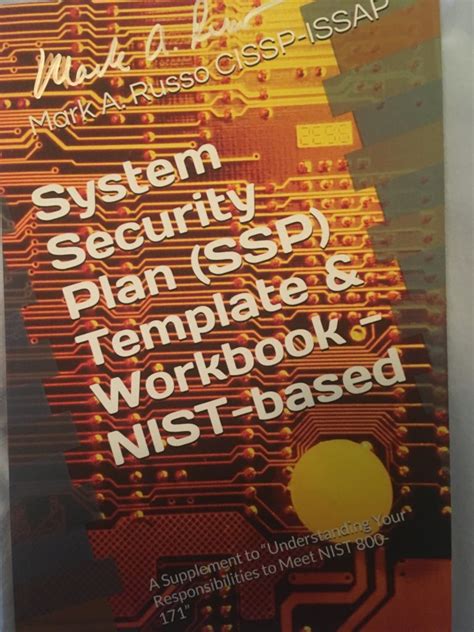The NIST 800-171 system security plan template is a crucial document for organizations that handle Controlled Unclassified Information (CUI) and want to ensure the security and integrity of their systems. In this article, we will provide a comprehensive guide to creating a NIST 800-171 system security plan template, including the essential elements, best practices, and a step-by-step approach to implementation.
Understanding NIST 800-171
The National Institute of Standards and Technology (NIST) Special Publication 800-171 is a set of guidelines for protecting the confidentiality, integrity, and availability of CUI in non-federal information systems and organizations. The publication outlines a set of security requirements and guidelines for protecting CUI, including system security plans, access controls, incident response, and more.

Why is a System Security Plan Template Important?
A system security plan template is essential for organizations that handle CUI, as it provides a structured approach to implementing the security requirements outlined in NIST 800-171. A well-developed system security plan template helps organizations to:
- Identify and assess security risks
- Implement security controls and countermeasures
- Continuously monitor and evaluate the effectiveness of security controls
- Ensure compliance with NIST 800-171 requirements
Key Elements of a NIST 800-171 System Security Plan Template
A NIST 800-171 system security plan template should include the following essential elements:
- System Description: A description of the system, including its purpose, functionality, and scope.
- Security Controls: A description of the security controls implemented to protect the system, including access controls, authentication, authorization, and more.
- Risk Assessment: A risk assessment of the system, including the identification of potential security risks and vulnerabilities.
- Security Requirements: A description of the security requirements for the system, including the NIST 800-171 security controls.
- Implementation Plan: A plan for implementing the security controls and requirements, including timelines and milestones.
- Continuity and Disaster Recovery: A plan for ensuring continuity of operations and disaster recovery in the event of a security incident.
- Incident Response: A plan for responding to security incidents, including procedures for reporting, responding, and recovering from incidents.
Best Practices for Creating a NIST 800-171 System Security Plan Template
When creating a NIST 800-171 system security plan template, follow these best practices:
- Use a risk-based approach: Identify potential security risks and vulnerabilities, and prioritize security controls and countermeasures based on risk.
- Involve stakeholders: Involve stakeholders from across the organization in the development and review of the system security plan template.
- Keep it concise: Keep the system security plan template concise and easy to read, avoiding unnecessary technical jargon.
- Use clear and concise language: Use clear and concise language, avoiding ambiguity and ensuring that the plan is easy to understand.
- Review and update regularly: Review and update the system security plan template regularly, ensuring that it remains relevant and effective.
Step-by-Step Approach to Implementing a NIST 800-171 System Security Plan Template
Implementing a NIST 800-171 system security plan template involves the following steps:
- Step 1: Identify the System: Identify the system that requires a system security plan template, including its purpose, functionality, and scope.
- Step 2: Conduct a Risk Assessment: Conduct a risk assessment of the system, identifying potential security risks and vulnerabilities.
- Step 3: Develop the System Security Plan Template: Develop the system security plan template, including the essential elements outlined above.
- Step 4: Implement Security Controls: Implement the security controls and requirements outlined in the system security plan template.
- Step 5: Continuously Monitor and Evaluate: Continuously monitor and evaluate the effectiveness of the security controls and requirements.

Conclusion
In conclusion, a NIST 800-171 system security plan template is a critical document for organizations that handle CUI. By following the essential elements, best practices, and step-by-step approach outlined in this guide, organizations can ensure the security and integrity of their systems and comply with NIST 800-171 requirements.
Additional Resources
- NIST Special Publication 800-171: Protecting Controlled Unclassified Information in Nonfederal Information Systems and Organizations
- NIST Cybersecurity Framework: A framework for managing and reducing cybersecurity risk
FAQ Section
What is NIST 800-171?
+NIST 800-171 is a set of guidelines for protecting the confidentiality, integrity, and availability of Controlled Unclassified Information (CUI) in non-federal information systems and organizations.
Why is a system security plan template important?
+A system security plan template is essential for organizations that handle CUI, as it provides a structured approach to implementing the security requirements outlined in NIST 800-171.
What are the key elements of a NIST 800-171 system security plan template?
+The key elements of a NIST 800-171 system security plan template include system description, security controls, risk assessment, security requirements, implementation plan, continuity and disaster recovery, and incident response.
Gallery






